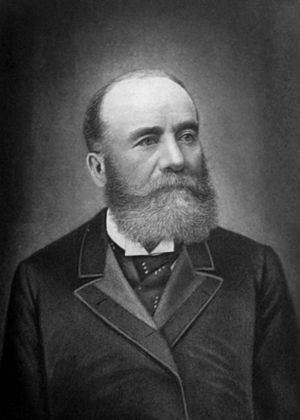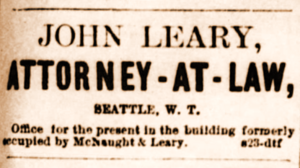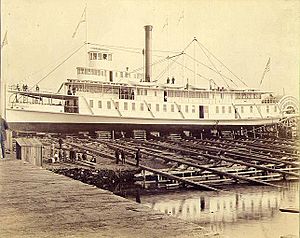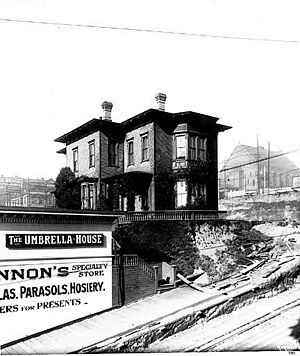John Leary (politician) facts for kids
Quick facts for kids
John J. Leary
|
|
|---|---|
 |
|
| Born | November 1, 1837 Saint John, New Brunswick, Canada
|
| Died | February 8, 1905 (aged 67) |
| Burial place | Lake View Cemetery |
| Occupation |
|
| Years active | 1869–1893 |
| Known for | Pioneer and civic leader of Seattle, one of Seattle's early mayors, a successful entrepreneur |
| Political party | Republican |
| Spouse(s) |
|
| Mayor of Seattle | |
| In office August 3, 1884 – August 3, 1885 |
|
| Preceded by | Henry G. Struve |
| Succeeded by | Henry Yesler |
| Signature | |
 |
|
John Leary (November 1, 1837 – February 8, 1905) was an important businessman and politician in Seattle, Washington. He helped shape the city during its early years. Leary was involved in many different businesses and civic projects.
He started his career in the lumber business in Canada when he was just 17. He became very successful and moved to Seattle in 1869 looking for more opportunities. By the time he died, John Leary was one of the richest people in Seattle. Most of his money came from buying and selling land in and around the city. He also helped with railroads, mining, banking, and water systems. Even though some of his projects didn't make money, they were important for Seattle's growth. He was also known for giving a lot of money to charity.
Leary served as a Seattle councilman many times and was mayor in 1885. He helped start the Seattle Chamber of Commerce, the Rainier Club, and Seattle's first bank, the First National Bank of Seattle. From 1878 to 1890, Leary was a key player in Seattle's fight to get its own railroad connection. This was super important for Seattle to become a major city in Washington State.
He also paid for the building of the Bailey Gatzert steamboat, which was the best ship on Puget Sound back then. His mining work led to the founding of Ravensdale, Washington, a town first named after him. His home, which was the most expensive house in Seattle at the time, is now on the National Register of Historic Places. Two streets in Seattle, Leary Way and Leary Avenue, are named after him.
Contents
Early Life and Business
John Leary was born on November 1, 1837, in Saint John, New Brunswick, Canada. His family was from Ireland. From a young age, he showed a talent for business. At 17, he started a successful business trading lumber in St. John. This business grew to include the nearby town of Woodstock.
By the time he was 30, he had earned a good amount of money. He even ran his own lumber camp. However, a trade agreement between Canada and the U.S. ended in 1866. This caused problems for Leary's business. He tried to move his business to Maine, but soon decided to try his luck out West. He continued working in lumber until 1867.
Moving to Seattle
In 1869, Leary arrived in Seattle. Back then, Seattle was a small village with less than 1,000 people and no paved streets. Unlike many business people at the time, Leary didn't stick to just one type of business. He got involved in many different things.
A journalist named Samuel L. Crawford once said that Leary had a very active mind. He loved to start big projects. He would get them going and then move on to something new. Because of this, he helped start many important projects in Seattle. Over the next 20 years, Leary was involved in many businesses at the same time. He touched "every line of public progress" in Seattle, often without making a profit himself.
Despite this, by the early 1900s, Leary had become very rich. His fortune was estimated at $2 million, which would be about $53 million today. Most of this money came from his smart investments in Seattle land. He died as one of the wealthiest people in the city.
Leary's Law Career
In 1871, John Leary became a lawyer in Washington Territory. He joined a law firm called McNaught & Leary. By 1872, this firm was one of only five in Seattle. It was also one of the busiest law firms in the entire Washington Territory. Being a lawyer was one of Leary's main jobs in Seattle for eleven years.
In 1878, his partner, James F. McNaught, became a lawyer for the Northern Pacific Railroad Company. This caused their law firm to break up. Leary first started his own law practice. Then, he formed a new firm with Henry G. Struve. This firm was called Struve & Leary Company. In 1880, another lawyer joined, and it became Struve, Haines & Leary. Leary stayed with this firm until 1882. After that, he focused more on his business and community work.
Mining Ventures
In 1872, Leary opened the Talbot coal mine near what is now Renton, Washington. He worked with partners John Collins and James F. McNaught. Leary was later chosen as one of the mine's directors. This mine was the first to send coal to Seattle. To get to the coal, they built a long tunnel. They also laid a mile of railroad track to ship the coal to Seattle. However, the coal bed had many problems, so the mine closed after a few years.
Between 1878 and 1880, Leary paid for several trips to explore the land in Washington. These trips were usually paid for by the government. The explorers looked at the West Coast, the Skagit and Similkameen rivers, and parts of Eastern Washington. These trips confirmed that there were rich deposits of coal and iron. The reports from these trips were shared with everyone.
In 1884, Leary helped open the Cedar River mines. He also owned early shares in other mines near Renton.
Leary's biggest mining project was creating the Leary Coal Company. This company developed coal mines in Ravensdale, Washington. Leary founded this mining town, and it was first named after him. The mine's output grew from 48,000 tons in 1900 to 185,000 tons by 1905. Large amounts of coal could be shipped because of a special railroad line. This line was paid for by other railroad projects Leary was involved in. It connected the mines to the Northern Pacific Railway. After Leary died, the mine was sold to Northern Pacific. The mine continued to produce a lot of coal until 1915, when an accident caused it to close.
Building Seattle's Utilities
Leary started many projects that helped build Seattle's basic services, even if they didn't always make money.
In November 1881, the Spring Hill Water Company started laying water pipes in Seattle. Leary, along with Jacob Furth and Bailey Gatzert, had bought this company when it was having financial trouble. They pumped water from Lake Washington, creating Seattle's first water system. By 1886, it could provide 200,000 gallons of water. Leary was president of this company for a time. In 1890, he and his partners sold the company to the city for $352,000 (about $9 million today).
Leary also helped start Seattle's first gas company. He was its president until 1878.
Banking in Seattle
In September 1882, Leary helped create Seattle's first bank, the First National Bank of Seattle. Before this, only a loan business existed in town. Leary's partners included famous banker William S. Ladd from Oregon, Seattle's richest citizen Henry Yesler, and others. The bank opened on November 15, 1882, with $150,000 (about $4 million today) in starting money.
The bank was strong and stable, which helped Seattle get through the Panic of 1893, a time of economic trouble. Leary was the bank's president, but he later had to step down because he had too many other business interests. The First National Bank later joined with Seafirst Bank, which was then bought by the Bank of America.
In 1889, Leary was also on the board of trustees for the People's Savings Bank in Seattle.
Media and Newspapers
In 1878, Leary started the Seattle Post newspaper. He was the main owner of the paper from 1880 until 1882. Then, he arranged for it to merge with another paper, the Seattle Intelligencer. He also built a new, modern office building for the combined paper, the Seattle Post-Intelligencer, in a great location. By 1884, Leary had sold all his shares in the newspaper.
In 1890, Leary and some partners bought the Seattle Trade Journal. A year later, he sold it to The Seattle Telegraph. Leary was also a major owner of the Morning Journal Publishing company in 1890. This company tried to publish a Democratic newspaper called the Morning Journal, but it wasn't successful and was taken over by the Telegraph the next year.
Real Estate Investments
Leary invested a lot in real estate because he strongly believed in the future of Washington Territory, especially Seattle. His belief was right, and his land investments became the main way he earned his fortune.
For example, in 1883, Leary, along with Judge Thomas Burke and William R. Ballard, bought 700 acres of land on Salmon Bay. Around 1890, this land was divided into smaller plots and sold to new settlers. This area became the city of Ballard, which is now part of Seattle.
Other important investments by Leary included the Cosmopolitan Hotel, the Seattle Post building, and the Yesler-Leary Block. The Yesler-Leary Block was built in 1883. It was considered the most important commercial building and the largest office building in Seattle at the time. It was built with Henry Yesler and cost over $100,000 (about $3 million today). Sadly, this building was destroyed in the Great Seattle Fire on June 6, 1889.
Politics and Community Work
Like most people who settled in Washington Territory at the time, Leary was a Republican. People who knew him described him as an "outstanding civic leader" and a "natural leader."
Leary served three terms as a Seattle councilman, in 1873, 1875, and 1876.
In 1884, he was elected mayor of Seattle, serving from 1884 to 1885. Seattle citizens cheered for him at one of the biggest political meetings ever held in Occidental Square. Leary was elected mayor on a ticket supported by businessmen. At the time, the mayor's job didn't pay a salary; it was seen as a duty to the community. Leary was the first mayor to have regular office hours. He worked on improving downtown streets and even used his own money to pave 1st Avenue, which was Seattle's first paved street. Leary ran for re-election but lost.
In late 1885 and early 1886, there was a lot of anger against Chinese people in many Western cities. This was due to racism and economic problems. Many white Americans blamed Chinese workers for the economic downturn. This anger turned violent in some places. When this anger reached Seattle, Leary tried to convince the Chinese people to leave the city before any violence happened, but he was not successful. There were intense anti-Chinese riots in Seattle, and eventually, a group in Seattle decided to try to force all Chinese people out of Western Washington.
In 1890, Leary was a founding member of the board of trustees for the Seattle Chamber of Commerce. He served as the Chamber's president for two terms, first in 1890–1891.
In 1892, during an economic slowdown, Leary ran for mayor again as a Republican but lost.
Improving Transportation
Seattle's First Railroads
The Northern Pacific Railroad was the first major railroad to reach Puget Sound. In 1873, after years of planning, the railroad surprisingly chose Tacoma as its main stop in the West, not Seattle. This decision meant that most trade would go to Tacoma, leaving Seattle in a less important position. Seattle's people, who relied on trade, panicked and thought about moving their businesses and families to Tacoma.
Leary helped calm the panic with a clever trick. He sold one of his hotels for $600 (about $16,000 today). He used that money to buy many wooden piles. He then sank these piles in straight lines where a railroad track might go into Seattle. This made it look like someone was building a railroad to Seattle. Rumors spread, stopping the panic and keeping people from leaving Seattle.
To solve the problem for good, Seattle needed its own railroad connection. The Northern Pacific Railroad had invested a lot in Tacoma land and was trying to get Seattle residents to move there.
Leary's trick led to the creation of the Seattle and Walla Walla Railroad. This railroad planned to connect Seattle to Walla Walla through Snoqualmie Pass. This would bring some trade to the Port of Seattle. Many important citizens helped pay for the project, but Leary was not among the first investors. It soon became clear that Walla Walla wasn't very interested, and Seattle's money alone wasn't enough. The railroad construction started in 1874 but never went beyond King County.
In 1881, a change in leadership at Northern Pacific led the company to connect with the Seattle and Walla Walla Railroad. Train service to Seattle began in 1884. However, Northern Pacific still used its power to help its Tacoma businesses and treated Seattle merchants unfairly.
The problem wasn't fully solved until Seattle started another railroad, the Seattle, Lake Shore and Eastern Railway (SLS&E). This railroad would connect Seattle to the Canadian Pacific Railway by going through Snohomish, Sedro-Woolley, and Sumas. This would allow Seattle to avoid the Northern Pacific Railroad entirely. Leary was one of the people who helped organize, start, direct, and invest in the SLS&E. However, most of the money came from bankers in New York.
Leary played a key role in the final fight for Seattle's independent railroad connection. In 1885, as the SLS&E was building towards Snohomish, a judge in Tacoma issued an order to stop the building of a vital bridge in Snohomish. This order, requested by Northern Pacific, would have caused delays. These delays would have broken the financial agreement with the New York bankers, putting the whole project at risk. Leary, along with Judge Thomas Burke, quickly took a SLS&E train to Snohomish. They arrived before the official order did. They convinced the local sheriff and his deputies to "disappear for a couple of days." This meant no one could enforce the order until the issue could be settled in court. By putting everyone to work, the SLS&E finished the bridge on time.
In 1882, Leary also helped start the Baker City Railway.
Maritime Shipping
In 1877, Leary co-owned a ship called the Zephyr with George Harris and Captain William Ballard. In 1879, Leary and Harris sold their shares, and Ballard became the only owner.
Once Seattle had its railroad connections, shipping by sea grew rapidly. In 1890, about $1 million (about $26 million today) worth of new steamboats were added to the fleets of companies operating from Seattle. Leary helped by starting the Seattle Steam Navigation & Transportation Company. This company had $500,000 (about $13 million today) in starting money. Leary was the company's first president.
Leary built the steamboat Bailey Gatzert for his company. It was one of the best steamboats of its time. It was named after Leary's friend and business partner, Bailey Gatzert. The ship cost between $100,000 and $125,000 (about $2.6 million to $3.3 million today).
In 1891, steamboat companies combined to form the Columbia River & Puget Sound Navigation Company. Leary became the vice-president. This new company owned several steamboats, including Leary's Bailey Gatzert. They traveled between Puget Sound and Victoria, British Columbia.
Leary also played a big part in setting up the first mail route from Seattle to Alaska.
Other Contributions
Leary organized and was president of several other companies. These included the West Coast Improvement Company, Seattle Land & Improvement Company, and the Seattle Warehouse & Elevator Company. He was also a director and supporter of the James Street & Broadway Cable & Electric line and the West Street & North End Electric Railway Company.
Leary was a member of the Irish National League of America's governing council. He was also on the University of Washington Board of Regents. He worked to make education and textbooks free for all students.
Personal Life
Family and Home
John Leary was married twice but did not have any children. He married his first wife, Mary Blanchard, on November 26, 1858. She passed away on July 17, 1890.
On April 21, 1892, Leary married Eliza P. Ferry, who was the daughter of Governor Elisha P. Ferry.
The Leary family lived at the corner of 2nd Avenue and Madison Street. In 1903, Leary began building a new family home in Capitol Hill. This new house overlooked Lake Washington and was thought to be the most expensive private home in Seattle at the time.
The new house was not fully finished before Leary's death. However, it remained the home of his widow, Eliza, and was a famous place for social and charity events until she died in 1935. In 1948, a church group bought the house, and it remains their main office today. The house was added to the National Register of Historic Places in 1972.
At the time of his death, two of Leary's relatives were still alive: his sister Margaret Leary Baker and Jane Leary.
Charitable Giving
Leary was known for his many charitable activities. His friend, Alfred Battle, said Leary was "the most charitable man I ever knew. He gave money to everybody he thought needed it."
Both of Leary's wives were also involved in charity work. Mary B. Leary founded and was president of the Ladies Relief Society of Seattle. This group was started in 1884 to help families and individuals in need. Eliza P. Leary was an active member of Seattle's Sunset Club and a local chapter of the Daughters of the American Revolution.
Community Organizations
Leary was one of the original founders of the Rainier Club, which is one of Seattle's most respected organizations. He became its president in 1890 and served at least through 1891.
Leary was also an officer in Seattle's chapter of the Royal Arch Masons and a member of a local chapter of Odd Fellows.
Later Years and Legacy
In the last three years of his life, Leary suffered from liver disease. He stepped back from most of his business activities and spent a lot of time in Southern California. He also traveled to Germany for treatment.
John Leary passed away from heart failure in Riverside, California, on February 8, 1905. His funeral was held on February 15. He was buried at Lake View Cemetery in Capitol Hill.
Leary died as one of Seattle's wealthiest people, leaving a fortune worth $2 million (about $53 million today). Most of his money was left to his wife, Eliza. A street in Seattle, Leary Way, was named after him to honor his contributions to the city.
Images for kids







